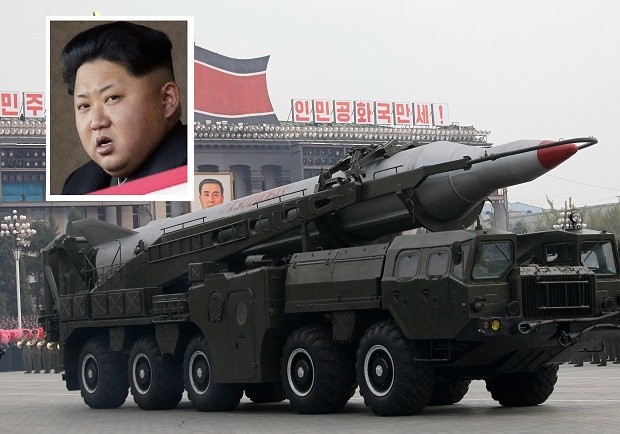North Korea leader brags missile threatens US Pacific bases

In this Oct. 10, 2010 file photo, North Korea missiles on trucks make its way during a massive military parade to mark the 65th anniversary of the communist nation’s ruling Workers’ Party in Pyongyang, North Korea. Nuclear-armed North Korea has hundreds of ballistic missiles that can target its neighbors in Northeast Asia but it will need foreign technology to upgrade its arsenal and pose a more direct threat to the United States, U.S. researchers said. AP
Seoul, South Korea — North Korean leader Kim Jong-Un has hailed the successful test of a powerful new medium-range missile, saying it poses a direct threat to US military bases in the Pacific, state media reported Thursday.
Kim, who personally monitored Wednesday’s Musudan missile test, said it was a “great event” that significantly bolstered the North’s preemptive nuclear attack capability, the official KCNA news agency reported.
READ: North Korea test fires two powerful, mid-range missiles | A coronation for North Korea’s Kim Jong-Un
Article continues after this advertisementArticle continues after this advertisement
“We have the sure capability to attack in an overall and practical way the Americans in the Pacific operation theater,” Kim was quoted as saying.
The Musudan — also known as the Hwasong-10 — has a theoretical range of anywhere between 2,500 and 4,000 kilometers (1,550 to 2,500 miles).
The lower estimate covers the whole of South Korea and Japan, while the upper range would include US military bases on Guam.
After a string of failures in recent months, North Korea tested two Musudans on Wednesday, one of which flew 400 kilometers into the Sea of Japan (East Sea).
KCNA said the missile had been fired at a high angle to simulate its full range and had reached a maximum height of more than 1,400 kilometers.
The success of the test “marked an important occasion in further strengthening the nuclear attack capacity of our state,” Kim said, providing the “guarantee” of a fully-developed strategic weapons system.
Wednesday’s launch was condemned by the international community, with the president of the UN Security Council urging a swift response to a “clear an unacceptable” violation of UN resolutions.
“We favor a quick and firm reaction of the Security Council,” said Francois Delattre of France, ahead of an emergency meeting called to discuss the tests.
“Confronted by the threat of proliferation, we consider that weakness is not an option.”
Significant step forward
Existing UN measures prohibit North Korea from using ballistic missile technology.
The United States, NATO and Japan also denounced the test, with South Korea vowing to push for tighter sanctions on Pyongyang.
Four previous Musudan tests this year failed either on their mobile launch pad or shortly after take-off.
Experts said Wednesday’s apparent success marked a significant step forward for a weapons program that ultimately aspires to develop a proven nuclear strike capability against the US mainland.
“Policymakers need to focus on a testing ban to prevent this from becoming a working missile,” said Melissa Hanham, an expert on North Korea’s WMD program at the Middlebury Institute of International Studies in California.
In its report, KCNA stressed that reducing the missile’s flight range to 400 kilometers by increasing the trajectory meant the test had posed no danger to neighboring countries like Japan.
The Japanese government has said its military will shoot down any North Korean missile that threatens its territory.
The international outcry over the Musudan test suggests North Korea could face renewed sanctions, either on a unilateral level or from the United Nations.
After Pyongyang conducted a fourth nuclear test on January 6, followed by a long-range rocket launch February 7, the Security Council adopted its most punishing sanctions yet against North Korea.
Any further measures would require the support of veto-wielding permanent council member China, traditionally the North’s closest ally.
Responding to Wednesday’s launch, China’s foreign ministry had cautioned against “any action that may escalate tension” and called for a resumed dialogue on Pyongyang’s nuclear drive.